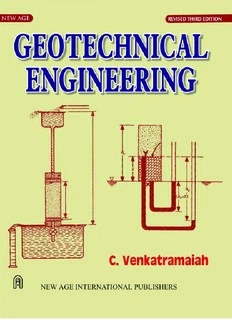Table Of Content
GEOTECHNICAL
ENGINEERING
THIS PAGE IS
BLANK
Copyright © 2006, 1995, 1993 New Age International (P) Ltd., Publishers
Published by New Age International (P) Ltd., Publishers
All rights reserved.
No part of this ebook may be reproduced in any form, by photostat, microfilm,
xerography, or any other means, or incorporated into any information retrieval
system, electronic or mechanical, without the written permission of the publisher.
All inquiries should be emailed to [email protected]
ISBN (10) : 81-224-2338-8
ISBN (13) : 978-81-224-2338-9
PUBLISHING FOR ONE WORLD
NEW AGE INTERNATIONAL (P) LIMITED, PUBLISHERS
4835/24, Ansari Road, Daryaganj, New Delhi - 110002
Visit us at www.newagepublishers.com
Dedicated to the memory of
My Parenu-in-l_
Smt. Ramalakshmi
&
Dr. A. Venkat& Subba Bao
for ,1Mb-'-and o/Yeetio,.lo".. and
aU 1M meMbue ofm y (Gmjly.
THIS PAGE IS
BLANK
THE 1'Hnm
PREFACE TO EDITION
With the enthusiastic response to the Second Edition of "GEOTECHNICAL ENGINEERING"
from the academic community. the author has undertaken the task of preparing the Third
Edition.
The important features of this Edition are minor revision/additions in Chapters 7. 8, 10,
17 and 18 and change over of the Illustrative Examples and Praclice Problems originally left in
the MKS units into the S.I. units so that the book is completely in the S.I. units. This is because
the so-caned "Period of Transition" may be considered to have been over.
The topics involving minor revision/addition in the respective chapters specificaUy are :
Chapter 7 Estimation of the settlement due to secondary compression.
Chapter 8 Uses and appli.cations of Skempton'g pore pressure parameters, and
"Stress-path" approach and its usefulness.
Chapter 10 Unifonn load on an annular area (Ring foundation).
Chapter 17 Reinforced Earth and Geosynthetics, and their applications in
geotechnical practice.
Chapter 18 The art of preparing a soil investigation report.
Only brief and elementary treatment of the above has been given.
Consequential changes at the appropriate places in the text, contents, answers to nu
merical problems, section numbers, figure numbers, chapter-wise references, and the indices
have also been made.
A few printing errors noticed in the previous edition have been rectified. The reader is
requested to refer to the latest revised versions of the 1.8. Codes mentioned in the book.
In view of all these, it is hoped that the bouk would prove even more useful to the stu
dents than the previous edition.
The author wishes to thank the geotechnical enbrineenng fraternity for the excellent
support given to his book.
Finally, the author thanks the Publishers for bringing out this Edition in a relatively
short time, while impro.ving the quality of production.
C. Venkatramaiah
Tirupati
India
Vii
THIS PAGE IS
BLANK
THE EnmON
PREFACE TO FIRST
The author does not intend to be apologetic for adding yet another book to the existing list in
the field of Geotechnical Engineering. For onc thing, the number of books avaiiable cannot be
considered too large, although certain excellent reference books by Stalwarts in the field are
available. For another, the number of books by Indian Authors is only a few. Specifically speak.
ing, the number of books in this field in the S.I. System of Units is small, and books from Indian
authors are virtually negligible. This fact, coupled with the author's observation that not many
books are available designed specifically to meet the requirements of undergraduate curncu
lum in Civil Engineering and Technology, has been the motivation to undertake this venture.
The special features of this book are as follows:
1. The S.L System of Units is adopted along with the equivalents in the M.K.S. Units in
some instances. (A note on the S.l. Units commonly used in Geotechnical Engineer
ing is included).
2. Reference is made to the relevant Indian Standards·, wherever applicable, and ex
tracts from these are quoted for the benefit of the student as well a8 the practising
engineer.
3. A 'few illustrative problems and problems for practice are given in the M.K.S. Units
to facilitate those who continue to use these Units during the transition period.
4. The number of illustrative problems is fairly large compared to that in other books.
This aspect would be helpful to the student to appreciate the various types of prob
lems likely to be encountered.
5. The number of problems for practice at the end of each chapter is also fairly large.
The answers to the numerical Froblems are given at the end of the book.
6. The illustrative examples and problems are graded carefully with regard to the
toughness.
7. A few objective questions are also included at the end. This feature would be useful
to students even during their preparation for competitive and other examinations
such as GATE.
B. "Summary of Main Points", given at the end of each Chapter, would be vcr)' helpful
to a student trying to brush up his preparatiun on the eve of the examination.
9. Chapter-wise references are given; this is CODl,!idered a better way to encourage fur
ther reading than a big Bibliography at the end .
• Note: References are invited to the latest editions ofthesc specifications for further details. These
standards are available from Indian Standards Institution, New Delhi and it.s Regional Branch and In
epection Offices at Ahmedabad, Bangalorc. Bhopal. llhubaneshwar. Bombay, Calcutta. Chandigarh,
Hyderabad, Jaipur. Kanpur, Madras, Patnn. Pune and Trivilndrum.
ix

